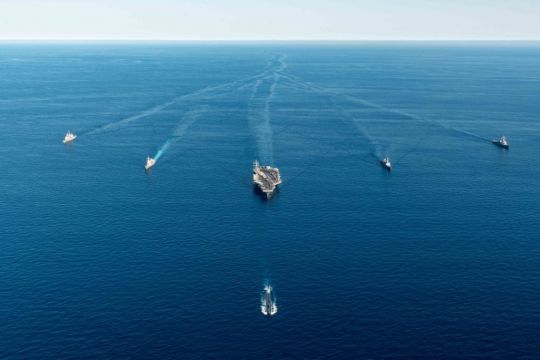South Korean, American and Japanese warships have launched their first trilateral anti-submarine drills in five years, after North Korea renewed missile tests this week in an apparent response to bilateral training by South Korean and US forces.
The North’s five missiles launches, the first in a month, came before and after US vice president Kamala Harris visited South Korea on Thursday and reaffirmed the “ironclad” US commitment to the security of its Asian allies.
The one-day training off the Korean peninsula’s east coast is meant to cope with a North Korean push to advance its ability to fire missile from submarines, according to a South Korean navy statement.

Pyongyang has been building bigger submarines including a nuclear-powered one and testing sophisticated missiles that can be fired from them in recent years.
That is an alarming development for its rivals because it is harder to detect underwater-launched missiles in advance.
South Korean officials said last weekend that they had detected signs that North Korea was preparing to test-fire a missile from a submarine.
Friday’s drills involve the nuclear-powered aircraft carrier USS Ronald Reagan as well as US, South Korean and Japanese destroyers, the navy statement said.

During the training, the navy ships from the three nations were to search and track a US nuclear-powered submarine posing as a North Korean sub while exchanging related information, according to media reports.
“We will respond and neutralise any forms of North Korean provocations in an overwhelming and decisive manner,” said Captain Cho Chung-ho, commander of the South Korean navy troops who took part in the training.
In addition to its submarine-launched missiles, North Korea also has a variety of nuclear-capable missiles that place the three collaborating countries within striking distance.
This year, Pyongyang has performed a record number of missile tests as it refuses to resume long-stalled nuclear diplomacy with the US.

Friday’s training comes as South Korea and Japan try to mend ties frayed over history and trade disputes.
The two Asian countries together host a total of 80,000 American troops. Earlier this week, the USS Ronald Reagan took part in joint US-South Korean drills near the peninsula, the first such bilateral involving a US aircraft carrier since 2017.
The North’s most recent missile tests happened on Thursday, hours after Ms Harris left South Korea.
During her visit to the demilitarised zone separating the two Koreas, she said: “In the South, we see a thriving democracy. In the North, we see a brutal dictatorship.”







